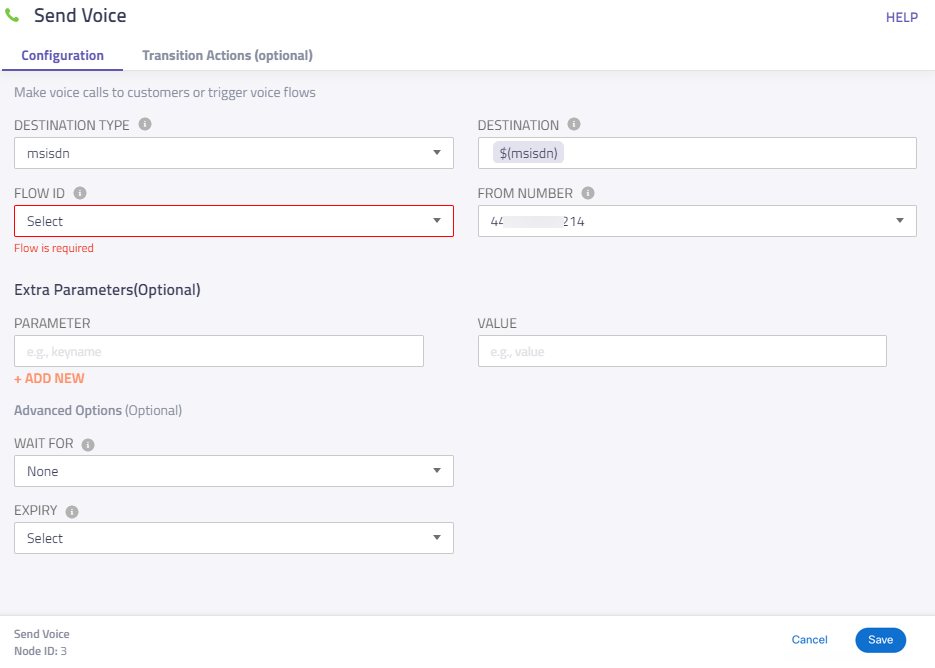Send Voice Node [Deprecated]
Deprecation Alert
Please note that this node was deprecated alongside the deprecation of the voice flow builder in release 5.4.x. This is supported only for tenants that have some legacy flows set-up using the old voice flow builder, and has been deprecated in general. If you want to use Webex Connect for building voice flows please use the new voice nodes that include Call User Node, Play Node, Record Node, Collect Input Node, IVR Menu Node, and Call Patch Node.
The Voice node enables you to initiate an Integrated Voice Response (IVR) voice call with a customer. When the call is initiated, you can seek the response of the customer from their keypad. Based on the response, an appropriate flow is continued. You can configure a wait time in minutes to receive the customer response. The call may end if the response is not received within the wait time.
For example, a bank initiates an IVR voice call with its customer on credit card offers. Based on the customers' response, an SMS is sent to the sales team or customer support team. If the customer does not respond within the specified time, then the call gets disconnected.
When you double-click the Voice node, the Voice screen appears with two tabs: Configuration and Transition Actions. The Configuration tab enables you to configure the voice call settings whereas the Transitions tab provides configuring the node on-enter/on-leave operations.
Here is the node image:

Node Configuration
Drag-and-drop the voice node on to the visual flow builder and double click it to open the configuration window.
| S. No | Element | Description |
|---|---|---|
| 1 | Configuration tab | Use this tab to configure the message settings. Here is the description for the fields: DESTINATION TYPE Select Customer ID or msisdn from this drop-down box. DESTINATION If msisdn is selected from the Destination Type drop-down box, then specify the mobile number or the variable in which the mobile number is stored. MESSAGE TYPE Choose the message type from this drop-down box. Here is the description for the message types: _ Flow ID: Use this option to trigger a voice flow. After selecting this option, select Flow ID from the Flow ID drop-down box. _ Media: Use this option to play the uploaded audio file. After selecting this option, select Audio from the Media drop-down box. WAIT FOR This drop-down box contains the below option: _ Answer: Use this option to make the flow to wait for customer's answer. EXPIRY This drop-down box contains the below two options: _ UTC: Use this option to specify the date when the message should expire. _ Seconds: Use this option to specify the message expiry time in seconds. SENDER ID Use this option to select the the Phone number from which the message is sent. EXTRA PARAMETERS _ Name and Value: Use these fields to specify the key value pairs to be forwarded. Note: Configuring these fields is optional. |
| 2 | Transition Actions tab | Use this tab to configure node on-enter/on-leave operations. Here is the description for the fields: Add action link Click it to view the Transition action fields. |
| 3 | Input Variable | Click this collapsible panel to view the list of all the available flow variables. You can search for a variable using the Search field. You can also add a variable to the flow variables list by clicking the Add new flow variable link at the bottom of the list. |
| 4 | Output Variables | Click this collapsible panel to view the output variables. The data generated by the node is displayed as variables here. |
| 5 | Node Outcomes | Click this collapsible panel to view the list of possible node outcomes. You can also customize the node labels by clicking the Edit icon. |

Configuring Voice Calls
Using the Voice node, you have two options to configure voice calls: Triggering voice flow and Playing media file.
Here is the description:
Triggering Voice Flow
- Double click the Voice node.
The Voice screen appears. - On the Voice screen:
- From the Destination Type drop-down box, do either of the following:
- Select the Customer ID, and then enter the customer ID in the Destination field. The node fetches the customer number from the Customer ID.
- Select the msisdn, and then specify the mobile number or the variable (in which the mobile number is stored) in the Destination field.
- From the Message Type drop-down box, select Flow Id, and then select the Flow ID from the Flow ID drop-down box.
- From the Wait for drop-down box, select Answer.
- From the Expiry drop-down box, specify UTC or Seconds.
Note: Use the UTC option to specify the date when the message should expire. If you wish to specify the message expiry time in seconds. then use the Seconds option. - From the Sender ID drop-down box, select the phone number from which the message is sent.
- Click the Save button at the bottom.
The voice flow is configured.
Playing Media File
- Double click the Voice node.
The Voice screen appears. - On the Voice screen:
- From the Destination Type drop-down box, do either of the following:
- Select the Customer ID, and then enter the customer ID in the Destination field. The node fetches the customer number from the Customer ID.
- Select the msisdn, and then specify the mobile number or the variable, in which the mobile number is stored.
- From the Message Type drop-down box, select Media, and then select the Audio File from the Media drop-down box.
- From the Wait for drop-down box, select Answer.
- From the Expiry drop-down box, specify UTC or Seconds.
Note: Use the UTC option to specify the date when the message should expire. If you wish to specify the message expiry time in seconds. then use the Seconds option. - From the Sender ID drop-down box, select the phone number from which the message is sent.
- Click the Save button at the bottom.
The voice flow is configured.
Configuring Transitions Actions
As part of configuring transition actions, you can configure on-enter/on-leave operations. However, configuring these are optional.
Here are the steps:
- On the Voice screen, click the Transition Actions tab.
- On the Transition Actions tab, click Add Action.
The Transition Actions area appears. - On the Transition Actions area:
- From the Time drop-down box, select On-enter or On-leave. For example, On-enter.
- From the Acton drop-down box, select an action choosing from the pre-built options.
Tip
To delete an event, click the delete button corresponding to that event. See the image below.

Delete Button
- Click the Save button at the bottom.
The transition actions are configured.
Updated about 1 month ago
